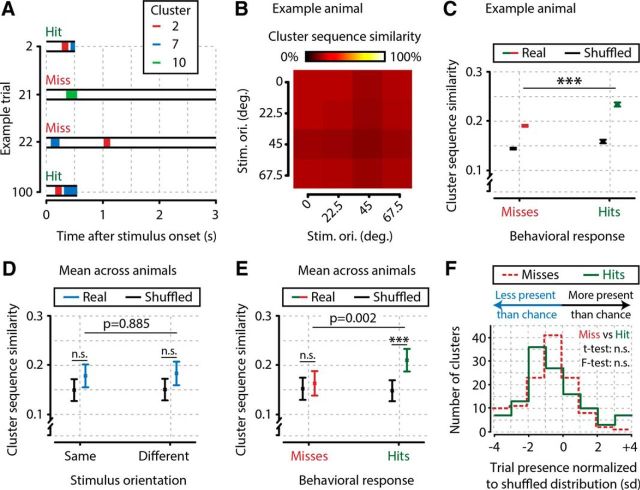Figure 6.
Clusters occur in more similar sequences during trials where the stimulus is detected than during trials where it remains undetected. A, Cluster occurrences during four example trials, including also nonrecurring clusters (i.e., cluster 10). Trials 2 and 100 show a sequence similarity of 1.0, whereas the other combinations of trials show a similarity of 0.0. B, Cluster sequence similarity for this example animal is not higher for trials with the same stimulus orientation (diagonal entries) than for trials with different orientation (off-diagonal entries), showing that stimulus orientation is not encoded in the sequence of cluster occurrences (all t tests between sequence similarities based on stimulus orientation, p > 0.05; not significant). C, Same example animal as in B, showing a higher cluster sequence similarity between hit trials than between miss trials (p = 1.04 × 10−28, n = 9702 hit trial pairs, n = 26,406 miss trial pairs). Black bars represent baseline (shuffled) similarity values expected by chance. D, Across animals, we found no evidence for stimulus orientation being encoded by sequences of clusters (same orientation trial pairs: t test of real vs shuffled, p = 0.330; different orientation trial pairs: t test of real vs shuffled, p = 0.384; t test of same vs different orientation trial pairs: p = 0.885; n = 8 animals). E, Cluster sequence similarity is higher between hit trials than between miss trials (t test, p = 0.002), and sequence similarity between hit trials is higher than expected by chance (hits: t test of real vs shuffled: p = 5.7 × 10−5), but not for miss trials (misses: t test of real vs shuffled, p = 0.202). F, The enhanced sequence similarity for hit trials cannot be explained by particular clusters occurring preferentially during hit or miss trials: the distribution of cluster presence during trials, normalized to chance, is not different for hits and misses in terms of mean and variance; hits (mean = −0.433, SD = 2.140) versus misses (mean = −0.890, SD = 1.843), t test, p = 0.079; F test, p = 0.106; n = 119 clusters (including nonrecurring clusters). ***, p < 0.001. n.s., Not significant.

